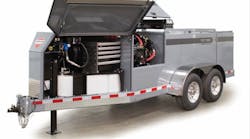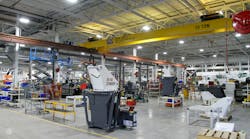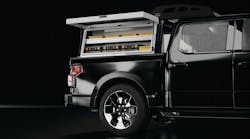For those who depend on drivelines, there is no such thing as good vibrations. When drivelines shake, components fail, Tom Koedam said at a workshop on driveshafts and universal joints held at the NTEA convention in St Louis.
And when drivelines experience vibrations, the common cause is a mechanic who did not adhere to basic principles.
"I am convinced that many of the problems we experience-failures of pumps, gears breaking in PTOs, and PTO mounting bolts coming loose-are caused by improper driveshaft installations," said Koedam, driveshaft brand development manager for the Drivetrain Services Division of Dana Corporation. "Very rarely does anything other than installation errors produce vibrations that are strong enough to cause hydraulic pumps and power take-offs to fail."
Koedam listed three types of vibrations that troubleshooters should know-transverse, torsional, and critical speed vibrations.
Transverse vibrations occur once per revolution. They usually are caused by an imbalance in the driveshaft or an imbalance between the driveshaft and its connecting members. The solution is simple-have the driveshaft balanced.
Torsional vibrations occur twice every time the driveshaft rotates. These result from excessive angles in the u-joints. They also can be caused by driveshafts that have been reassembled out of phase. A phased driveshaft generally is one in which the yokes are in line. However, it is not uncommon for chassis manufacturers to order driveshafts with special phasing.
"Torsional vibrations are one of the biggest installation problems you will encounter," Koedam said.
Koedam suggested that shops mark driveline components before disassembling them. Mark them in a way that makes it clear that the driveline is being reassembled the same way the manufacturer built it.
One good way to identify specially phased drivelines is to look at the weld seam on the tubing. If the weld seam is straight but the yoke is turned, the driveline probably has been built out of phase.
U-Joint Operating Angles
U-joint operating angles-the angle produced between the driving member (such as the transmission or a power take-off) and a driveshaft-are major factors in driveline vibration problems.
Both ends of a driveline have an operating angle-formed at one end between the driving member and one end of the driveshaft and on the other end between the driveshaft and the component being driven. U-joints can operate either at simple angles (the direction changes only in one plane) or at a compound angle (the direction changes in two planes).
Simple driveline operating angles can be found with a protractor. Measure the slopes of both ends of the driveline and subtract the difference.
Added Complexity
With compound angles, the parts components of the driveline do not line up in the top view or in the side view. To determine the size of a compound angle, it must be measured in the side view and the top view. The angle in the top view can be calculated by measuring the length of the driveshaft and the amount of the lateral offset. Looking up those dimensions on a chart available from Spicer will provide the angle-without the use of trigonometry. The true u-joint operating angle is a combination of the top- and side-view angles. It is the square root of the result one receives when adding the square of the top-view angle and the square of the side-view angle.
"Even though we calculate the angles for the top and side views, this final calculated compound angle is the only one you need to control in your installation," Koedam said. "But you have to control it on both ends of the driveshaft."
Spicer has developed guides for u-joint operating angles. * Keep the true angles less than 3 degrees if possible. Three-degree operating angles do not produce vibrations severe enough to cause damage, Koedam said. * Keep the angles on each end equal within one degree. When the angles at both ends are equal, they cancel out the torsional vibration that is generated at the drive end of the driveshaft. * Never assemble a driveline so that both ends are exactly the same. The roller bearings in u-joints must have a half-degree difference in order to rotate. Why U-Joints Vibrate
Unlike the constant velocity joints found on many automobiles, u-joints vibrate twice per revolution when placed at an angle. The nonuniform velocity of the u-joint and the driveshaft connected to it is what causes the vibration.
Koedam has measured the variation in velocity as driveshafts rotate. When a u-joint is placed at a 30-degree angle and rotated at a constant speed of 1000 rpm, the driveshaft actually speeds up to 1300 rpm and slows down to 700 rpm. If the other end of the driveshaft has a similar 30-degree angle, it slows down to 700 rpm at the same time that the other end speeds up to 1300 rpm.
"If the angles of the front and rear u-joints are within a degree of one another, the speeds of the input and output yokes are exact opposites," Koedam said. "It cancels the torsional vibrations and also delivers a uniform speed to the output yoke-just like the front yoke. If these angles aren't equal, the torsionals at the front of the driveline are transferred to all of the components. These torsional vibrations can cause significant problems in vehicles."
Having the driveline in phase is especially important if the driveline must operate with high u-joint operating angles. The higher the operating angle, the more vibration an out-of-phase driveline produces, Koedam said. How It Happens Koedam said that a problem occurs when mechanics remove the driveshaft by pulling it out of the slip yoke. By being off just one tooth, the driveline can vibrate. "We only allow the driveline to be out of phase by one degree," Koedam said. "If you are one tooth off, the driveline is out of phase by 221/2 degrees."
Torsional vibrations cause a wide range of failures, including transmission synchronizers.
Critical speed vibrations are produced when the driveshaft turns excessively fast.
To decrease the chances of having a driveshaft vibration problem: * Always have driveshafts balanced. * Have driveshafts assembled in phase. Mark existing shafts so that they can be reassembled with the original phasing. * Know the true operating angles of the U-joint and never assemble a driveline with excessive operating angles.
Critical Speed
The most important concept involving drivelines is critical speed-turning the driveshaft too fast for its particular length, diameter, and material. When a shaft rotates too quickly, it tends to bow out like a jump rope and eventually tears itself apart.
"All the other problems cause u-joint kits and other materials to fail," Koedam said. "Driveshafts that approach critical speed begin to vibrate violently. It almost always breaks in the middle of the tube and gets thrown out from beneath the vehicle. Innocent people can get injured, and lawyers love it."
Critical speed is contingent upon the mass of the shaft, its length, and the style of the shaft. Spicer offers a driveshaft speed calculator that can be used to select the proper driveshaft for the speed at which it will operate.
Koedam used the calculator to illustrate how lengthening the driveshaft reduces the speed at which it can safely turn. After distributing calculators to the audience, Koedam showed how the critical speed of one driveshaft was well above the operating range of a particular truck. By replacing it with a shaft that is 40 inches longer lowered the critical speed to 1500 rpm.
"I can guarantee that this driveshaft will fail," he said. "If you are the installer or the guy who specs the shaft, it is your job to make sure that the driveshaft will operate safely-even if it means using a more expensive setup."
Avoid the Problem
Koedam recommends using a direct-mount hydraulic pump wherever possible to avoid having to install a driveline.
"We sell driveshafts, and we enjoy doing so," Koedam said. "But auxiliary driveshafts are a big headache for everyone. They are hard to set angles, and people get tangled up in them. That is why we prefer that direct-mount pumps be used whenever possible."
Koedam offered suggestions for those who install hydraulic pumps powered by auxiliary drivelines.
* Place the driveline in a remote location. Koedam told of one installation where the driveline could be used as a step-with disastrous results. It should not be located where someone could get entangled in it.
* Use proper warnings on the side of the frame rail.
* Install guarding around the driveshaft. "In lawsuits, one of the first questions is 'Why wasn't the driveshaft guarded?' The typical response is, 'Because it costs more money.' This is a bad answer," Koedam said.
He closed with this advice:
* Keep u-joint operating angles small.
* Make sure that the u-joint operating angles at each end of the shaft are equal.
* Always have the driveshaft balanced. ♦








